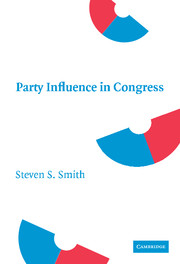Book contents
- Frontmatter
- Contents
- Acknowledgments
- 1 Introduction
- 2 The Microfoundations of Theories of Congressional Parties
- 3 The Types and Sources of Party Influence
- 4 The Search for Direct Party Effects
- 5 Recent Theories of Party Influence: Cartel and Conditional Party Government Theory
- 6 Revisiting Pivotal and Party Politics
- 7 Reexamining the Direct and Indirect Influence of Party in the House and Senate
- 8 More Than a Conclusion
- Appendix
- References
- Index
3 - The Types and Sources of Party Influence
Published online by Cambridge University Press: 05 June 2012
- Frontmatter
- Contents
- Acknowledgments
- 1 Introduction
- 2 The Microfoundations of Theories of Congressional Parties
- 3 The Types and Sources of Party Influence
- 4 The Search for Direct Party Effects
- 5 Recent Theories of Party Influence: Cartel and Conditional Party Government Theory
- 6 Revisiting Pivotal and Party Politics
- 7 Reexamining the Direct and Indirect Influence of Party in the House and Senate
- 8 More Than a Conclusion
- Appendix
- References
- Index
Summary
The image of Lyndon Johnson browbeating a Senate colleague into supporting the party is familiar to most members of Congress and to all students of congressional politics. From time to time, party leaders use force of personality, appeals for loyalty, strong-arm tactics, and threats to gain compliance from difficult-to-persuade colleagues. Johnson relied on the technique – the “Johnson treatment,” it was called – more than other leaders, but pressuring individual legislators to gain pivotal support has a long history in Congress.
The political science literature is in a second phase. In the first phase, which ran into the 1970s, much of the political science research on Congress was a search for the direct influence of partisan forces on legislators' voting decisions. Unfortunately, while many stories can be told, and I will do some of that again in this chapter, finding systematic effects of this kind of party influence is unlikely and even contrary to expectation, at least for the most common approaches. Too few legislators on too few votes are involved for statistical estimates of this kind of party influence to show anything meaningful. I demonstrate this in the next chapter, where I consider old and new arguments that the old statistical findings are not trustworthy. In this chapter, I reestablish, if it is needed, the importance of this form of party influence in voting.
As both insiders and political scientists have observed, direct pressure on legislators hardly exhausts the forms that party influence may take.
- Type
- Chapter
- Information
- Party Influence in Congress , pp. 44 - 81Publisher: Cambridge University PressPrint publication year: 2007



